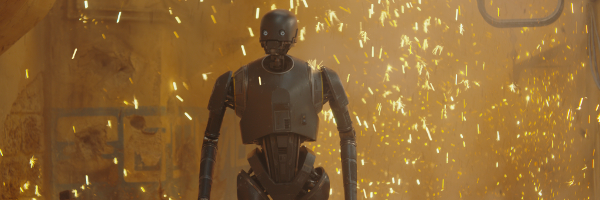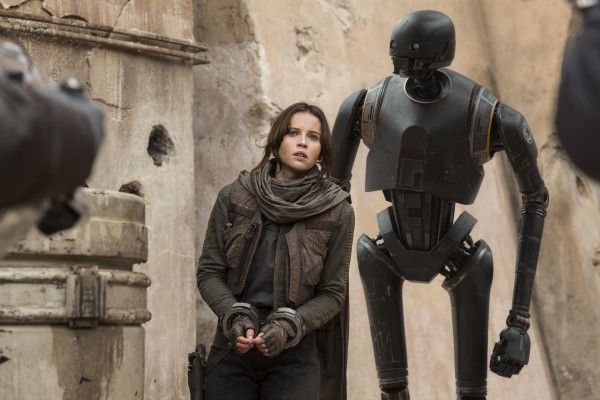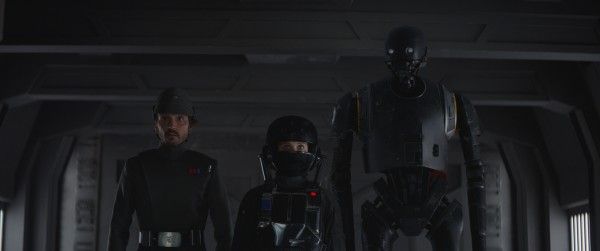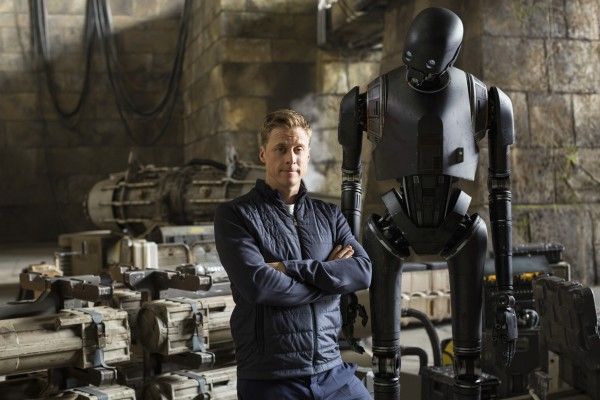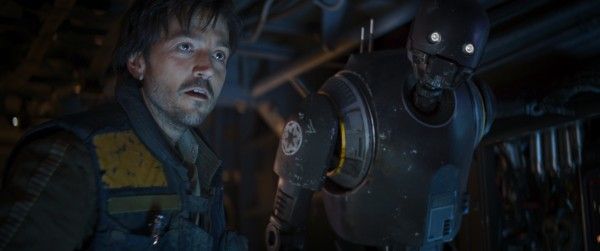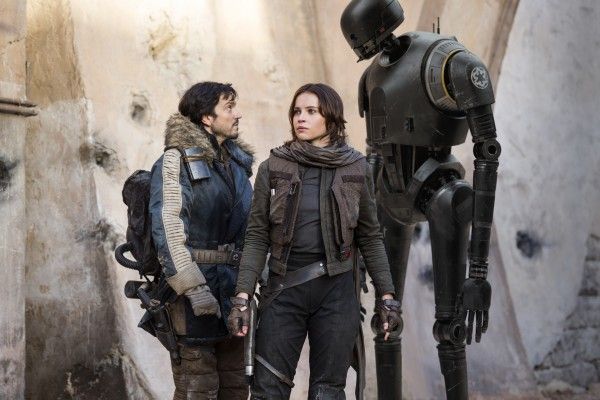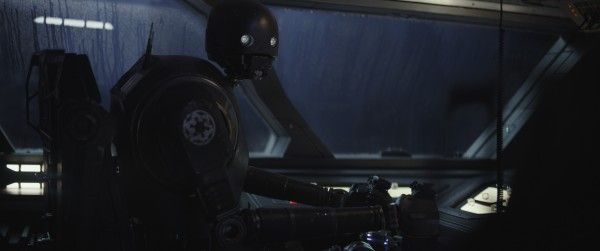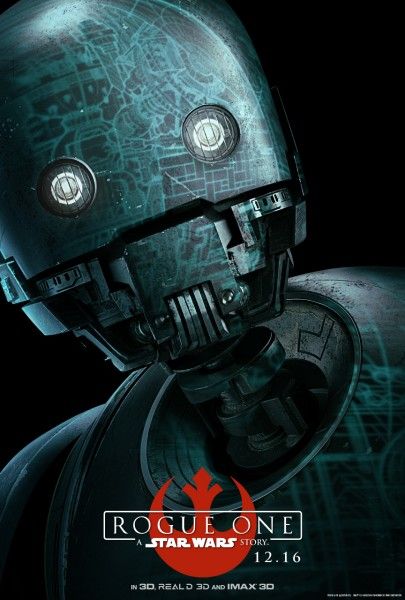Please be aware there are major spoilers for Rogue One.
Star Wars has a long, proud history of lovable droids and with Rogue One, Alan Tudyk's K-2S0 joins the ranks alongside R2 and BB-8 as one of the most charismatic robotic creature creations to ever hit the screen. The right-hand droid of Diego Luna's Cassian Andor, K-2S0 is a reprogrammed security droid of the Galactic Empire with a bit of a personality glitch: he just can't keep his mouth shut. With a skilled improv performer like Tudyk in the roll, who's become Disney's secret ace in the hole as a voice actor, K-2S0 is a riot who easily steals the film from his human counterparts.
And while Tudyk was bringing K-2S0's personality to life, the esteemed team of visual effects artists at Industrial Lights & Magic were tasked with creating his image and rendering Tudyk's performance to screen. Like the film itself, K-2S0 is both at home in the Star Wars tradition and unique in it. Likewise, the character was created by a high-tech update of the classic man in a suit. But instead of a practical droid exoskeleton, Tudyk put on a mo-cap suit, strapped into some stilts (gotta watch that eye line) and acted right alongside his co-stars.
With Rogue One now available on Blu-ray and DVD, I recently had the opportunity to visit the ILM campus in San Francisco, California, where I got a firsthand look at some of the high-tech sorcery that helped bring K-2S0 and the world of Rogue One to life. While there, I also sat down for a chat with Tudyk and animation supervisor Hal Hickel. We talked about how they approached the creating something new in the proud legacy of Star Wars droids, the biggest challenge in bringing K-2 to life, how much motion capture technology has evolved since Tudyk first embraced it in I, Robot, how K-2's death scene changed in the new ending, and who we need to protest to see the droid pop up in Episode IX. Read the full interview below.
How did you guys approach trying to do something new with a droid in the tradition and history of Star Wars?
HAL HICKEL: Yeah, I mean the tricky thing is well -- it's super exciting to make a new droid in Star Wars universe, they're very important to Star Wars, and so it's great, but a kind of a style book. Even the anthropomorphic droids don't tend to be, to have expressive faces. Moving face parts and things like that.
Though that was something Gareth wanted to explore, and something I think you were probably interested in as well, the likes see how expressive can we make him and have it still feel like Star Wars. So that was a design challenge. But, you know, in the end we didn't do a lot of that, we let his eyes rotate and that was about it, but you know, just getting the chance to create a droid with a different kind of personality then I think we've seen on any Star Wars droid and who gets to do different things. He gets to shoot a gun and throw Stormtroopers around. You know he gets to be kind of an action character in part of the film. Not just the comedy relief or whatever. He's got a great arc and he's new in a lot of ways I think for a Star Wars droid.
ALAN TUDYK: So much of that was in the script. That and talking with Gareth from the very beginning that he was, because of his reprogram, that he spoke his mind and whatever that might be. And then that gave me a freedom on set sometimes to just speak my mind and whatever came to my mind, so some of it was in the script and other stuff wasn't. But that's how Gareth liked to work, you know, really, finding that, the performance that isn't necessarily on the page but just once you know, the actors get a sense of their characters, like how do they take it to the next step and we're on set and sometimes that meant going a little bit further than the lines, and it became a lot of fun.
I just remember one, the, where the joke was what happens if they don't open the gate? Well, then we'll all be destroyed, we'll be pulled into the vacuum of space or whatever it is that Riz's character says. And I said, "Not me. I could survive in space." Like that kind of crap, just, that was just something I just said and they went "Oh yeah, let's do that, say that!" Which was great.
You bring up an interesting point. He can survive in space. He got pretty fucked up, but he is ultimately a machine and machines can be repaired. So who do we need to petition to see K-2SO in Episode 9?
TUDYK: I've been trying to figure it out. I haven't got a name for you, but I'm tracking him down.
Were you one of those people that signed a multi-film contract?
TUDYK: I don't know.
Uh-huh [not buying it].
TUDYK: I honestly don't. I don't pay attention to contracts. I've got people that do that!
Right.
TUDYK: That's why I'm an actor. Contracts, math, these things are difficult. Laundry, all these are complicated.
[Laughs] Alright, I'll give you a question you can answer. You did motion capture in I, Robot years ago and you did it again on this. I know you're not going to be super involved in the technical evolution, but from your point of view as a performer, how did it evolve over that time span?
TUDYK: So much. What's great about I, Robot was that they allowed for me to perform on set with everybody. It was six months, so it wasn't one of those performances where I was in a green screen world. There was some stuff I had to do in post, where I had to go by myself and it was terrible. It was truly terrible. I don't know how much of it they used. It was a bad idea and everybody agreed. So mainly it was done on set, but I think in post it was a lot harder to render because there were just all these references dots that they actually weren't able to sync with it all. They were just rendering by frame or something. I don't remember. They had to do a lot of takes. Right after, there had to be one pass where Will Smith and Bridget Moynahan had to do the scene without me on set and then they ... there was just all these steps after it was over which on the time and day was just really difficult.
But this one was not like that at all. We just shot it. We did it. Like any other movie. I just happened to be in pajamas and on stilts, but they were special pajamas. They weren't green, which I liked. I thought they looked much cooler. I've seen jackets like that at like Nike, you know, that same kind of pattern.
Very future-tech looking.
TUDYK: Future-tech looking. The German luge team did something very similar. Not that the Germans are known for their fashion, but still. They are athletes.
From the technical point of view, what was the biggest challenge of K-2S0?
HICKEL: Design was the first challenge. It was just figuring out the aspect of expressiveness, but also just his proportions and figuring out the scheme of putting Alan in the stilts and all that stuff to get him to match up. And then beyond that it was really just about making sure we didn't mess it up. You know we'd get this great scene with Alan, very funny, and the thing is, it would sit in that form in the edit for quite a while before we got our work done. You know, with where you'd see Alan in the scene. And everyone would laugh, and so for us, our job was to make sure that when we got done and we were seeing K2 and not Alan anymore, and that people still laughed.
That was basically our job. That was it in a nutshell. It's animated. That was our job, was to make sure what made people laugh before, would make people laugh now. Or cry. The death scene. We had to make sure that it wasn't Alan's sad face looking at us in the camera in the last dying moments, and when it was K2's, that we still cared. So that was really the biggest challenge because it's not just a technical process of extracting Alan's emotion and slapping on K2 and painting Alan out of the shot, those things have to happen, but the animators put a lot of love into the process of applying that emotion to K2, and making sure that what K2 is doing to his body is really reflecting what Alan was trying to do. Because the pantomime, you know, we can't see Alan's face, so the pantomime is a huge part of it. Of course, the voice is at least as much but we've really had to make sure if there was some tiny little angle to the head, or he dropped one shoulder even just a tiny amount, all that had to be right. You know, we had to see it on K2 it had to communicate as completely through K2 as it did in the footage of Alan, so.
How does that affect you as a performer, knowing that every minute detail and every tiny gesture is translating that way on screen?
TUDYK: You forget about it. You know, it's just like any acting role. You don't, you don't think about how you're moving after. Like, that's the work you do before you go on set. Like my character, the interior work, with K2. With the motion capture role though, setting boundaries was an integral part of it. That when we went up to the void and figured out how he was going to move. You know, this doesn't work, this does work.
What were some of the boundaries?
TUDYK: That subtlety in movement would read, but any emotional movement, any casual movement or emotional movement brought him to life in a way. Automaton movement spoke to something else. Which he does sometimes when he's walking he's not really, you know when he's not emotional, he's not emotional, but when there is emotion, don't be ... I didn't put any restrictions on myself.
I'm curious for both of you, what were some reference points? Like in terms of movement, maybe was there something you referenced, where did you guys look to come up with his look?
HICKEL: Design wise, Gareth had pursued that pretty far with our art department before I even got my hands on K-2, so I don't know all of the goals that Gareth had in mind. You know he's obviously a reprogrammed Imperial Droid, so I think they wanted him to look serious and potentially dangerous, which is great because he's actually being funny most of the time but the idea that he could be quite, he could basically be a weapon, I like that right from the beginning and in the end of the film it pays off. We get to see, he finally gets a gun, we get to see the you know, he's got perfect aim, he's super strong.
TUDYK: I was asking for a gun that whole movie! It was, I didn't get a gun in the first, it was the first death I had an original death, that was not the one in the movie.
Oh really?
TUDYK: Yeah I got shot by Krennic.
HICKEL: It makes me think there's some back story. Some adventure that he and Cassian went on right when they were first together, you know? Just been reprogrammed where he, really messed up.
TUDYK: Where he was replied fully reprogrammed he was on both sides maybe killing rebels.
HICKEL: Yeah, they're just not quite sure, because otherwise you kind of wonder, why wouldn't you give him a gun sooner? Look it, he's perfect aim, he's great!
TUDYK: We had, yeah, I was always asking, "why don't I have a gun? C'mon!" It was really the character.
So you didn't have a gun in the Krennic version?
TUDYK: I did not. I didn't get my hands on a gun. So I'm glad that it actually finally happened. I saw a version of it. It was really cool because I got to see a version of it before it was animated and I had this, it was like a foam type gun thing that acted as the foam gun, but I saw it with the laser coming out of it or the yeah, with the, is that a laser? What do they call it? It's not a laser, it's a blast. The blast came out of it and so I got to see me going poof, poof, poof, with actual, it's like I was shooting them. And they were falling down, so it was Alan Tudyk on stilts shooting storm troopers and falling down. It was pretty thrilling.

